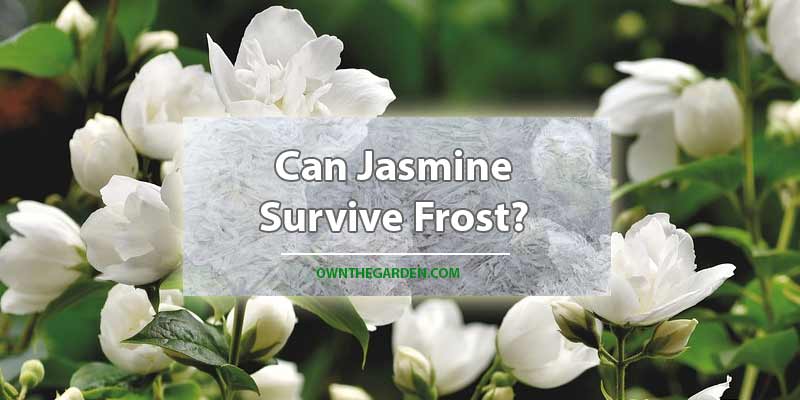The world cherishes Jasmine, an addition to gardens and landscapes renowned for its enchanting fragrance and delicate blooms. As winter draws near, questions may arise among gardeners regarding the endurance of these fragrant vines in the face of frosty temperatures.
This article delves into the cold tolerance of jasmine plants, and factors that influence their survival in frost, and provides tips on protecting them throughout winter.
Understanding Jasmine
The Oleaceae family harbors a diverse group of flowering plants, among them Jasmine. Aromatic white or yellow blossoms characterize jasmine species, renowned for their ornamental value and the essential oils derived from their flowers.
The most common varieties encompass Jasminum officinale (Common Jasmine), Jasminum sambac (Arabian Jasmine), and Jasminum polyanthum (Pink Jasmine).
Can Jasmine Survive Frost?
1. Cold Tolerance of Different Varieties
Among species and varieties, jasmine plants exhibit varying cold tolerance. For instance, while Jasminum officinale – a particular species of jasmine – can endure freezing temperatures due to its higher degree of cold hardiness; other species such as Jasminum polyanthum may suffer more from frost damage because they are less resistant.
2. Temperature Thresholds
Generally, jasmine plants prefer mild to warm climates; they are not innately adapted for severe cold resistance. Most varieties of jasmine, though, can tolerate temperatures as low as approximately 20°F to 25°F (-6°C to -4°C). Extended exposure below these thresholds — particularly in periods of intense cold — may cause frost damage.
Factors Influencing Jasmine’s Resilience to Frost
1. Plant Health and Vigor
More likely to endure adverse conditions, including frost, are healthy and well-established jasmine plants. Proper care and good health often result in these plants exhibiting greater resilience to stress.
2. Acclimatization
During the fall, Jasmine plants gradually acclimate to cooler temperatures; this preparation equips them for upcoming winter conditions. By methodically adjusting to lower degrees, these plants stave off sudden frost damage, a strategy that ultimately minimizes risk.
3. Plant Location
Whether jasmine plants reside in the ground or within containers, their survivability against frost hinges on this location. The vulnerability of container-grown jasmine to freezing temperatures increases; its roots lack the same level of insulation as those nestled in soil.
4. Microclimates
A garden or planting area can foster microclimates that induce temperature variations: areas boasting good air circulation and inherent windbreaks often experience milder conditions.
This amelioration in climate risk—specifically, a reduction of frost damage to jasmine plants—is directly attributable to these environmental factors.
5 Tips for Protecting Jasmine During Frost
1. Covering Plants
Forecasting frost necessitates the application of a protective barrier to jasmine plants, such as frost cloth, blankets, or burlap. Crucially, the entire plant must be covered; this ensures that material reaches and traps heat at ground level – preventing any settling of frost on foliage.
2. Mulching Around Plants
Insulating the soil and shielding jasmine plant roots from extreme temperature fluctuations, the function of applying an organic mulch layer around their base.
Furthermore, by averting rapid cooling of soil, a protective measure against frost–mulching proves exceptionally beneficial.
3. Watering Strategies
In preparing jasmine plants for frost, one must ensure proper watering. Well-hydrated plants exhibit increased resilience to cold conditions. However, and this is a critical point, overwatering should be avoided; excessive moisture can instigate additional issues such as root rot.
4. Selecting Cold-Hardy Varieties
Consider choosing cold-hardy jasmine varieties if you live in an area prone to severe winter temperatures. Compared to other species, Jasminum officinale – commonly known as Common Jasmine – thrives more robustly in colder climates.
5. Potted Jasmine
During frosty periods, move your container-grown jasmine to a sheltered location – consider a covered porch or garage. This simple action adds an extra layer of protection against the freezing temperatures.
Observing and Responding to Frost Damage
Jasmine plants, despite preventative measures, may present signs of frost damage. Wilted or discolored leaves and foliage browning represent common symptoms; in severe instances—the affected parts can even succumb to death. Should you encounter frost damage, consider these steps.
1. Assess the Extent of Damage
Assess the frost damage’s depth on the jasmine plant; should only a fraction of it be affected, consider trimming those injured leaves or stems. This strategy could enable the redirection of energy towards healthier sections within the plant.
2. Prune Damaged Growth
Using clean, sharp pruning shears, actively prune any visibly damaged or discolored growth. Ensure to make clean cuts above healthy buds or branches; this will encourage the emergence of new growth.
3. Evaluate the Roots
Should you observe healthy roots, the jasmine plant likely possesses a capacity for recovery; therefore, inspect with gentleness, the roots. Should there be any signs of rot or damage, trim away these issues: soft or discolored roots. If necessary, contemplate repotting your plant to promote its rejuvenation.
Conclusion
The alluring fragrance and elegant blooms of Jasmine captivate the senses as it emerges like a jewel in the garden. Although this plant may not naturally withstand harsh winter conditions, strategic care coupled with protective measures enhances its resilience to frost.
Gardeners who understand the factors that influence cold tolerance can take proactive steps to ensure enduring beauty and fragrance from jasmine graces their outdoor spaces even when winter’s chill sets in. Let the delicate blooms of jasmine enchant and thrive as the winter season approaches, imparting a touch of warmth within our frosty landscape.



